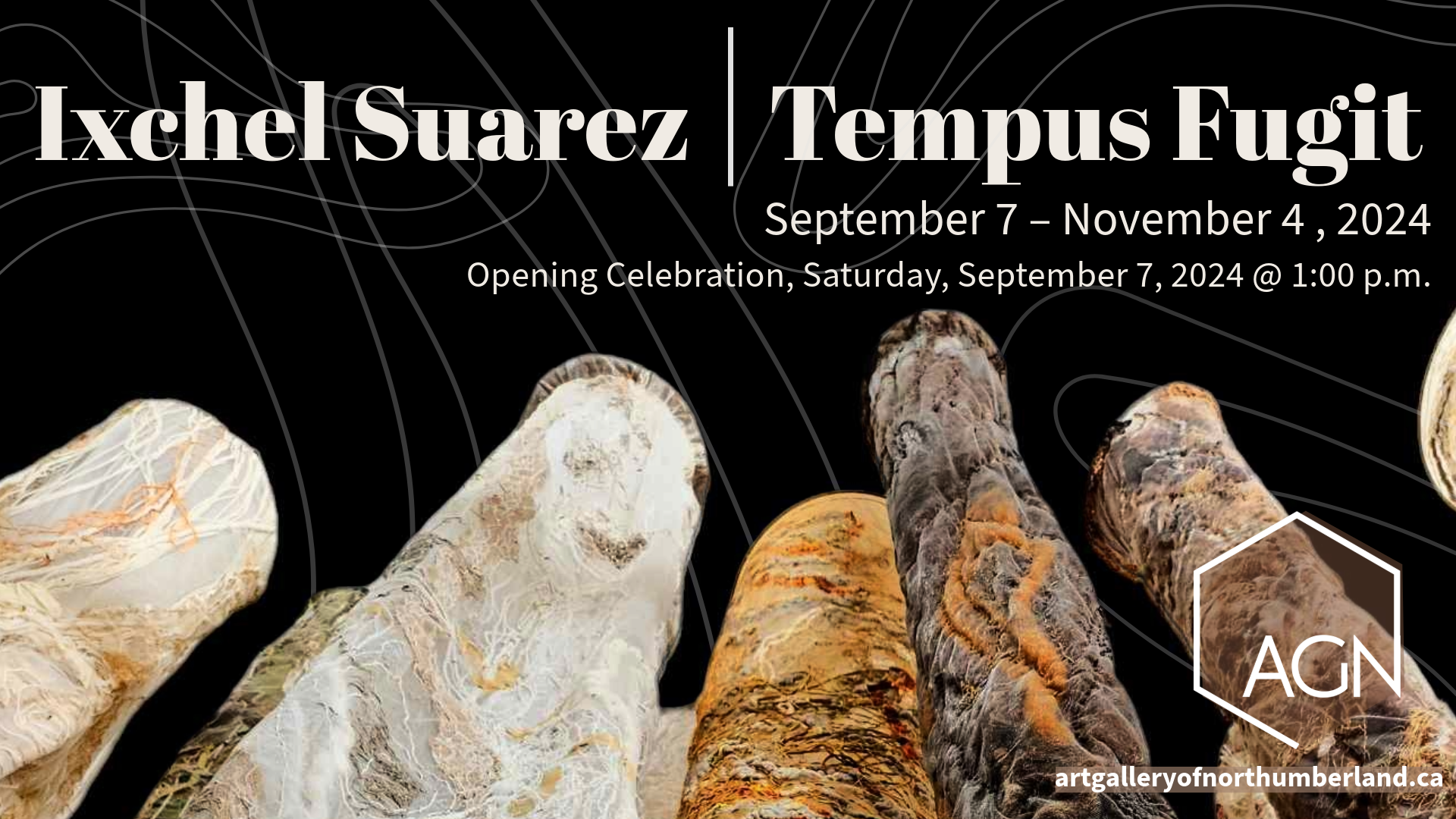Ixchel Suarez | Tempus Fugit

Opening Celebration September 7 at 1:00 p.m.
Tempus Fugit, ‘fleeting time’, by Mexican Canadian textile and tapestry artist Ixchel Suarez explores the life of trees through the lens of time, focusing on transitions, permanency and decay, aging, adaptation, rooting, and living in diaspora. Throughout the history of art, up until Modernism, nature was depicted separately from human space, distinct from the constructed environment. In fact, cities were once tightly woven to protect us from danger – the wild world – that existed outside our homes and communities. The tightly stitched fabric of our cities, homes and domestic lives, was a grid, a patchwork of woven stories. Similarly, domestic traditions of weaving in grids are found everywhere, in all cultures, and in natural processes. I’m thinking of spider webs and root systems. Ixchel’s work breaks away from the grid even though weaving involves the use of a loom to combine two sets of threads at right angles to each other, forming a structural grid. While tapestry and weaving as an artform is ancient, a distinct medium, in Ixchel’s hands it connects with the multitude of art-historical practices, like painting, sculpture and architecture.
Tapestry also connects with music. Ixchel is the daughter of an artist, a violinist and conductor, in Mexico City. When I interviewed her for a Youtube series called ‘A View From the Easel’ for the Art Gallery of Northumberland she spoke about his influence, lovingly, glowingly. Similarly, Ixchel radiates with a nurturing love, the kind of love that allows connection through experiential learning. In Canada, she founded the Canadian Tapestry Centre which offers courses and lectures to the public. But before coming to Canada she studied abroad. At age seventeen, after her father suggested weaving based on her interest in pattern making and making clothes, she spent some time in San Miguel Allende learning traditional Mexican weaving. Upon returning to Mexico City while attending the Museum of Modern Art she discovered the work of contemporary post-war Polish artists, including the textile work of Magdalena Abakanowicz. She was inspired by this Polish artist’s use of natural fibres. Abakanowicz’s work was also sculptural and immersive. After studying graphic design in Mexico, she moved to Poland to further her studies. Her father had studied in Russia and encouraged Ixchel to also study abroad. Returning to Mexico she immediately started teaching textile and fibre art at the University level. Two kids later, time in Spain, she and her family moved to Canada, where her son and daughter both graduated from film school at Toronto Metropolitan University.
Today, Ixchel lives near the town of Warkworth, in Trent Hills. Never idle, Ixchel Suarez shows internationally. Her exhibition at the Art Gallery of Northumberland was conceived during the Pandemic. Working closely the AGN’s Executive Director Olinda Casimiro, the exhibition contains recent work inspired by Ixchel’s photographic work of local forests. The video accompanying the exhibition was created by her son Esteban Powell.
The name ‘Ixchel’ is Mayan. She is the goddess of the moon, of love, pregnancy, medicine, and weaving. Sitting at a loom, growing a tapestry is like experiencing pregnancy. “When you are done you cut the umbilical cord and release it to the universe… it is magical” as Ixchel explains with conductor-like hand gestures in interview.
“The clearest way into the Universe is through a forest wilderness.” John Muir
Imagine arriving to Canada from Mexico and experiencing an expansive local indigenous forest for the first time. Adjacent to the Oak Ridges Moraine, Ixchel’s studio – renovated and expanded through the skilled and art-full carpentry of Richard Watts – contains all the threads, fibres, images, and looms one would expect belonging to an established artist of her trajectory. Ixchel draws our attention towards the familiar, the fabric of the local watershed system of earth, rivers, trees and lakes. Viewing a map of the Oak Ridges Moraine’s intricate eco-system bears no relation to the contemporary grid imposed on it, the highways and infrastructure that create interference, that clash with seasonal weather conditions and habitation. One wonders, how long would it take for the forest to absorb, to bury and consume this constructed world, if abandoned? Tempus Fugit, fleeing time, is revelatory, not wasted. Spending time in a forest is the best use of time. Driving along the 401, however, is wasted time; what you see or experience in a car is isolation, disconnection, a certain kind of madness. The soft woven fabric made of trees, rivers, vectors of animals that pollinate above the ground and the roots that communicate below ground, offer up a map of a different kind. This map is represented in Ixchel’s creations; a map which allows us to better see a timeless world. The culture grown in Ixchel’s studio – shown in the gallery and taught around the world – is far from the culture of the fleeting Now. It delights, tickles, conjures and simply makes us feel good.
I know when an artist does good work, because their work always looks and feels much like their personality, which is why it’s always a privilege to meet living artists in their workspaces. Ixchel Suarez’s workspace and time in the forest is time well spent. Check out the exhibition, and then enter a forest, or do it the other way around. You’ll be pleased you did.